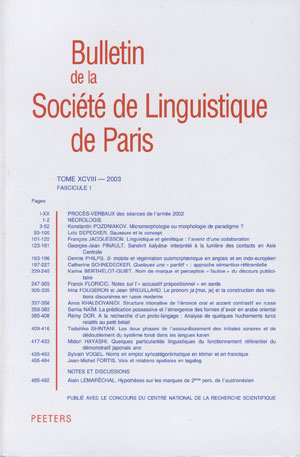 previous article in this issue previous article in this issue | next article in this issue  |

Preview first page |
Document Details : Title: La diversification fonctionnelle d'une catégorie grammaticale Subtitle: Quelques repères pour une description des participes en grec postclassique Author(s): TRONCI, Liana Journal: Bulletin de la Société de Linguistique de Paris Volume: 119 Date: 2024 Pages: 209-248 DOI: 10.2143/BSL.119.0.3294010 Abstract : Du grec ancien au grec moderne, la catégorie des participes a profondément changé: du système participial riche en formes et fonctions du grec ancien on est passé à une seule forme invariable de gérondif. Cet article explore une étape de ces changements, par une recherche sur le corpus des Apophtegmes des Pères, un recueil de brèves histoires composées oralement en Égypte et écrites ensuite en Palestine entre les IVe et VIe siècles après J.-C. L’étude vise à décrire comment les participes, en particulier les participes à fonction adverbiale, sont distribués du point de vue des fonctions ainsi que des formes. Les résultats les plus importants de l’étude portent sur deux aspects: (1) la distribution des participes aoristes par rapport aux participes présents; (2) la diffusion des génitifs absolus. Les participes présents sont employés en fonction adverbiale, alors que les participes aoristes expriment principalement des événements de premier plan, de la même façon que le verbe principal. Ils ont perdu leur fonction subordonnante et ont servi de marqueurs de la succession temporelle des événements. En ce qui concerne la fonction des génitifs absolus, ils sont souvent coréférentiels d’un argument de la phrase matrice, y compris le sujet: cela montre que l’opposition entre participes conjoints et absolus n’était plus stricte à l’époque, en raison de la perte progressive de l’accord en cas. Enfin, l’analyse de deux nouveaux types de constructions participiales (le type pseudocoordonné et le type présentatif) montre comment la persistance de la catégorie du participe a également été garantie par sa fixation dans des structures syntaxiques spécifiques. L’étude apporte une contribution plus générale à la reconstruction des chemins par lesquels le participe du grec ancien — une forme verbale non finie caractérisée par une grande richesse de formes et d’accords — a évolué vers la forme invariable du gérondif en grec moderne. This paper examines the forms and functions of participles in Postclassical Greek, focusing on the Apophthegmata Patrum. These are a collection of stories orally composed in Egypt and later written in Palestine, dating back to the fourth to sixth centuries AD. The research is corpus-based and aims to describe how participles, especially adverbial ones, are distributed in terms of verbal stems and functions. The main results of the analysis concern the distribution of aorist vs. present participles. While the latter exhibit the usual fonctions of the adverbial participles, conveying temporal, concessive, conditional, and causal meanings, the aorist participles mainly express foreground events, thus resembling the main clause. The typical syntactic configuration hosting aorist participles is as follows: a sequence of aorist participles denoting a succession of actions is concluded by the finite verb of the matrix clause. Aorist participles lost their subordinating function and served as markers of the temporal succession of events. A further result of the research concerns the function of the genitive absolutes. These are usually coreferential with an argument of the matrix clause, including the subject, showing that the opposition between conjunct and absolute participles was lost at that time, due to the weakening of case agreement. Lastly, the paper illustrates the spread of two types of participial constructions, namely the pseudocoordinated type and the presentative type. The study makes a more general contribution to the reconstruction of the paths through which the participle of Ancient Greek — a non-finite verbal form characterized by a great richness of forms and agreements — has evolved into the invariable form of the gerund in Modern Greek. |
|


